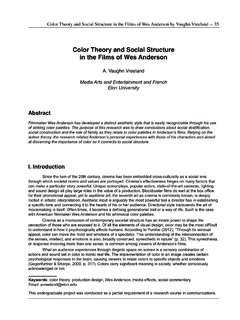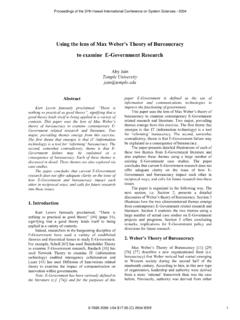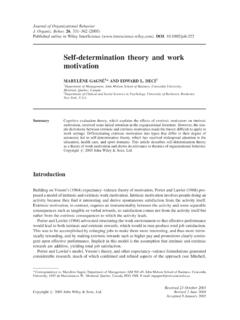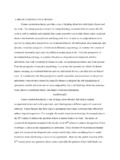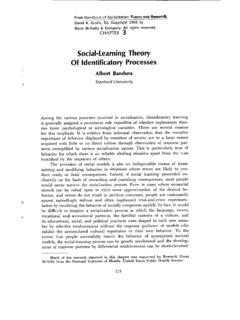Transcription of An Attributional Theory of Achievement Motivation and …
1 Psychological Review1985, Vol. 92, No. 4, 548-573 Copyright 1985 by the American Psychological Association, Attributional Theory of Achievement Motivation and EmotionBernard WeinerUniversity of California, Los AngelesA Theory of Motivation and emotion is proposed in which causal ascriptions playa key role. It is first documented that in Achievement -related contexts there are afew dominant causal perceptions. The perceived causes of success and failure sharethree common properties: locus, stability, and controllability, with intentionalityand globality as other possible causal structures. The perceived stability of causesinfluences changes in expectancy of success; all three dimensions of causality affecta variety of common emotional experiences, including anger, gratitude, guilt, hope-lessness, pity, pride, and shame. Expectancy and affect, in turn, are presumed toguide motivated behavior.
2 The Theory therefore relates the structure of thinking tothe dynamics of feeling and action. Analysis of a created motivational episode in-volving Achievement strivings is offered, and numerous empirical observations areexamined from this theoretical position. The strength of the empirical evidence,the capability of this Theory to address prevalent human emotions, and the potentialgenerality of the conception are 1645, Miyomota Musashi was contem-plating the causes of his past success as a war-rior. In A Book of Five Rings he mused,When I reached thirty I looked back on my past. The pre-vious victories were not due to my having mastered it was natural ability, or the order of heaven, orthat other schools' strategy was inferior. (1645/1974, p. 35)About 275 years later, and approximately11,000 miles away, the editors of ScientificAmerican were wondering why America wasflourishing.
3 They reasoned, "The wealth andgeneral prosperity of the country are largelydue to the intelligence and energy of its people,but it can hardly be disputed that it is equallydue to the natural wealth of the country" (Staff,1926, p. 228). Unfortunately, battles are lostas often as they are won, and countries undergoeconomic decline as well as enrichment. Dur-ing our recent financial recession the Los An-geles Times reported,Timber industry experts blame high interest rates, thehousing slump, tough logging regulation, and expansionThis article was written while the author was supportedby Grant MH38014 from the Public Health Service,National Institute of Mental author wishes to thank Sandra Graham for herhelpful comments on an earlier draft of this for reprints should be sent to Bernard Weiner,Department of Psychology, University of California, LosAngeles, California the Redwood National Park for their sorry state.
4 TimSkaggs, the union business agent, shrugged. 'You couldspend a lifetime fixing blame,' he said. (Martinez, 1982,Pt. 5, p. 1)And even the former coach of my favoritefootball team found it necessary to soul searchabout causality following a series of from the Los Angeles Times:Here it is Thanksgiving week, and the Los Angeles Ramsare looking like the biggest turkeys, in town. Coach RayMalavasi has eliminated bad luck, biorhythms, and sun-spots as the reasons why his football team has lost 9 of itslast 10 games. Now he's considering the unthinkable pos-sibilities that: (a) he has lousy players or (b) they aren'treally trying. (Robert, 1982, Pt. 3, p. 3)Why this constant pursuit of "why"? Anumber of explanations come to mind (seeForsyth, 1980; Weiner, 1985). We might justwant to know, that is, to understand the en-vironment, to penetrate ourselves and our sur-roundings.
5 This familiar motivational inter-pretation is known as the principle of mastery(White, 1959). In addition, it clearly is func-tional to know why an event has occurred. AsKelley (1971) stated, "The attributor is notsimply an attributor, a seeker after knowledge;his latent goal in attaining knowledge is thatof effective management of himself and his en-vironment" (p. 22). Once a cause, or causes,are assigned, effective management may bepossible and a prescription or guide for futureaction can be suggested. If the prior outcome548 Achievement Motivation AND EMOTION549was a success, then there is likely to be an at-tempt to reinstate the prior causal the other hand, if the prior outcome orevent was undesired such as exam failure,social rejection, political loss, or economic de-cline then there is a strong possibility thatthere will be an attempt to alter the causes toproduce a different (more positive) for mastery and functional search,two of the generators of causal exploration, donot seem to specifically characterize one geo-graphical area or one period of human Japanese warrior in the Middle Ages andtoday's union representative are engaged in thesame endeavor: attempting to assign , one might argue that adaptation is notpossible without causal analysis.
6 The warriorneeds to know why he is winning battles so hecan survive the next one, just as the union rep-resentative needs to explain why the industryis doing poorly in order to urge wiser actionsin the future. Because of the apparent pan-cultural, timeless aspect of causal search andexploration, and because of the evident adap-tive significance of this activity, causal ascrip-tions are proposed to provide the buildingblocks for the construction of a Theory of mo-tivation and article advances an Attributional theoryof Motivation and emotion, with achievementstrivings as the theoretical focus. Initially, themost salient causes of success and failure inachievement-related contexts are basic properties of these causes, or thestructure of causal thinking, is then deter-mined from both a dialectic and an empiricalperspective. Three causal dimensions are dis-covered: locus, stability, and structure of causal thinking is next relatedto emotion and Motivation .
7 Thus, this articleprogresses from a description of causal per-ceptions to causal structure, and then fromcausal structure to an examination of the dy-namics of action. It is documented that causalstability influences changes in goal anticipa-tions, while the three causal dimensions de-termine the emotional experiences of anger,gratitude, guilt, hopelessness, pity, pride, andshame. Guided by Expectancy X Value Theory ,I presume that expectancy and affect directmotivated behavior. Examples of research onthe disparate topics of parole decisions, smok-ing cessation, and helping behavior suggest thegeneralizability of the Theory beyond theachievement-related theoretical Causes of Success and FailureIn the opening paragraphs of this article,far-ranging examples of causal search are pro-vided. Many investigations have been con-ducted that more systematically examinecausal perceptions, particularly the perceivedcauses of success and failure in Achievement -related situations.
8 Two appropriate researchprocedures have been followed. In one, subjectsare provided only with outcome information,namely, that success or failure has taken outcome might be imagined, induced, orhave occurred in a real setting, and might per-tain to the subject or to another who is beingjudged. The subjects are then asked to explainthe outcome, using a free-response procedurewhere the possibilities that come to mind arelisted. In a related methodology, participantsare provided with a large list of causes and ratethe contribution of each cause to the causes often were ascertained in pilotresearch using a free-response methodology,and represent the dominant perceptions orembracing summary of 10 pertinent studies is pre-sented in Table 1. Table 1 reveals the sourceof the data, the characteristics of the sampleand task, and the four most dominant causalascriptions for success. The data for failure re-veal an identical story and are not message of Table 1 is clear, particularlyinasmuch as the research investigations madeuse of a variety of types of subjects judging avariety of Achievement situations, and involv-ing the self or another.
9 A virtually infinitenumber of causal ascriptions are available inmemory. However, within the achievementdomain, a relatively small number from thevast array tend to be salient. The most domi-nant of these causes are ability and effort. Thatis, success is ascribed to high ability and hardwork, and failure is attributed to low abilityand the absence of trying. This holds true forthe majority of cultures that have been ex-amined (see Triandis, 1972). The economy orsimplicity in causal thinking evident in theachievement domain appears in the explana-tion of other outcomes, such as wealth andpoverty (Feather & Davenport, 1981; Furn-550 BERNARD WEINERham, 1982a, 1982b) and affiliative acceptanceand rejection (Anderson, 1983a; Sobol & Earn,in press). However, relatively few studies havebeen conducted outside of Structure of Perceived CausalityI now turn from causal description andidentify the underlying structure of perceivedcausality.
10 A reasonable initial question to raiseis why does one want to determine causalstructure? What purpose or role does this playin the goal of Theory construction? In responseto this query, consider that, within any partic-ular activity, a myriad of distinct causal ex-planations are possible. Furthermore, for ex-ample, the causes of success and failure atachievement-related activities, such as abilityand effort, may be quite unlike the perceivedcauses of social acceptance and rejection, suchas personality or physical attractiveness. Onepuzzle that arises is the relation or the com-parability between the various causal expla-nations in what way(s) are ability and effort,or ability and physical beauty, alike and inwhat way(s) do they differ? A taxonomic struc-ture enables this question to be answered, forby finding the underlying properties of causes,or their common denominators, previous in-comparable qualitative distinctions can be re-placed with quantitative causal example, rather than merely being differ-ent, both ability and physical beauty may beconsidered properties of the actor and thus aresimilar, whereas they both differ from a causeTable 1 Investigations of the Perceived Causes of Success and FailureExperimentSubjectsPerspectiveTask Dominant attributionsFrieze (1976)College students Self and Hypothetical schoolother and gameperformanceElig & Frieze (1979) College students SelfFrieze & Snyder (1980) 1 st-5th graders OtherCooper & Burger (1980) TeachersBurger, Cooper, & Good Teachers(1982)Anderson (1983a)Willson& Palmer (1983)


